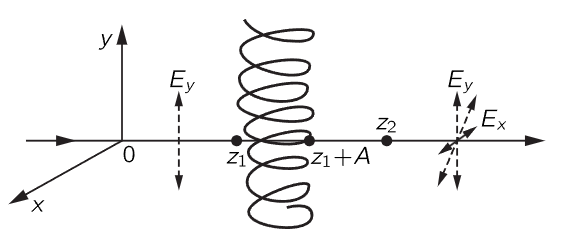
تاريخ الفيزياء

علماء الفيزياء


الفيزياء الكلاسيكية

الميكانيك

الديناميكا الحرارية


الكهربائية والمغناطيسية

الكهربائية

المغناطيسية

الكهرومغناطيسية


علم البصريات

تاريخ علم البصريات

الضوء

مواضيع عامة في علم البصريات

الصوت


الفيزياء الحديثة


النظرية النسبية

النظرية النسبية الخاصة

النظرية النسبية العامة

مواضيع عامة في النظرية النسبية

ميكانيكا الكم

الفيزياء الذرية

الفيزياء الجزيئية


الفيزياء النووية

مواضيع عامة في الفيزياء النووية

النشاط الاشعاعي


فيزياء الحالة الصلبة

الموصلات

أشباه الموصلات

العوازل

مواضيع عامة في الفيزياء الصلبة

فيزياء الجوامد


الليزر

أنواع الليزر

بعض تطبيقات الليزر

مواضيع عامة في الليزر


علم الفلك

تاريخ وعلماء علم الفلك

الثقوب السوداء


المجموعة الشمسية

الشمس

كوكب عطارد

كوكب الزهرة

كوكب الأرض

كوكب المريخ

كوكب المشتري

كوكب زحل

كوكب أورانوس

كوكب نبتون

كوكب بلوتو

القمر

كواكب ومواضيع اخرى

مواضيع عامة في علم الفلك

النجوم

البلازما

الألكترونيات

خواص المادة


الطاقة البديلة

الطاقة الشمسية

مواضيع عامة في الطاقة البديلة

المد والجزر

فيزياء الجسيمات


الفيزياء والعلوم الأخرى

الفيزياء الكيميائية

الفيزياء الرياضية

الفيزياء الحيوية

الفيزياء العامة


مواضيع عامة في الفيزياء

تجارب فيزيائية

مصطلحات وتعاريف فيزيائية

وحدات القياس الفيزيائية

طرائف الفيزياء

مواضيع اخرى
Optical activity
المؤلف:
Richard Feynman, Robert Leighton and Matthew Sands
المصدر:
The Feynman Lectures on Physics
الجزء والصفحة:
Volume I, Chapter 33
2024-03-24
1582
Another most remarkable effect of polarization is observed in materials composed of molecules which do not have reflection symmetry: molecules shaped something like a corkscrew, or like a gloved hand, or any shape which, if viewed through a mirror, would be reversed in the same way that a left-hand glove reflects as a right-hand glove. Suppose all of the molecules in the substance are the same, i.e., none is a mirror image of any other. Such a substance may show an interesting effect called optical activity, whereby as linearly polarized light passes through the substance, the direction of polarization rotates about the beam axis.

Fig. 33–5. A molecule with a shape that is not symmetric when reflected in a mirror. A beam of light, linearly polarized in the y-direction, falls on the molecule.
To understand the phenomenon of optical activity requires some calculation, but we can see qualitatively how the effect might come about, without actually carrying out the calculations. Consider an asymmetric molecule in the shape of a spiral, as shown in Fig. 33–5. Molecules need not actually be shaped like a corkscrew in order to exhibit optical activity, but this is a simple shape which we shall take as a typical example of those that do not have reflection symmetry. When a light beam linearly polarized along the y-direction falls on this molecule, the electric field will drive charges up and down the helix, thereby generating a current in the y-direction and radiating an electric field Ey polarized in the y-direction. However, if the electrons are constrained to move along the spiral, they must also move in the x-direction as they are driven up and down. When a current is flowing up the spiral, it is also flowing into the paper at z=z1 and out of the paper at z=z1+A, if A is the diameter of our molecular spiral. One might suppose that the current in the x-direction would produce no net radiation, since the currents are in opposite directions on opposite sides of the spiral. However, if we consider the x-components of the electric field arriving at z=z2, we see that the field radiated by the current at z=z1+A and the field radiated from z=z1 arrive at z2 separated in time by the amount A/c, and thus separated in phase by π+ωA/c. Since the phase difference is not exactly π, the two fields do not cancel exactly, and we are left with a small x-component in the electric field generated by the motion of the electrons in the molecule, whereas the driving electric field had only a y-component. This small x-component, added to the large y-component, produces a resultant field that is tilted slightly with respect to the y-axis, the original direction of polarization. As the light moves through the material, the direction of polarization rotates about the beam axis. By drawing a few examples and considering the currents that will be set in motion by an incident electric field, one can convince himself that the existence of optical activity and the sign of the rotation are independent of the orientation of the molecules.
Corn syrup is a common substance which possesses optical activity. The phenomenon is easily demonstrated with a polaroid sheet to produce a linearly polarized beam, a transmission cell containing corn syrup, and a second polaroid sheet to detect the rotation of the direction of polarization as the light passes through the corn syrup.
 الاكثر قراءة في مواضيع عامة في علم البصريات
الاكثر قراءة في مواضيع عامة في علم البصريات
 اخر الاخبار
اخر الاخبار
اخبار العتبة العباسية المقدسة

الآخبار الصحية















 "المهمة".. إصدار قصصي يوثّق القصص الفائزة في مسابقة فتوى الدفاع المقدسة للقصة القصيرة
"المهمة".. إصدار قصصي يوثّق القصص الفائزة في مسابقة فتوى الدفاع المقدسة للقصة القصيرة (نوافذ).. إصدار أدبي يوثق القصص الفائزة في مسابقة الإمام العسكري (عليه السلام)
(نوافذ).. إصدار أدبي يوثق القصص الفائزة في مسابقة الإمام العسكري (عليه السلام) قسم الشؤون الفكرية يصدر مجموعة قصصية بعنوان (قلوب بلا مأوى)
قسم الشؤون الفكرية يصدر مجموعة قصصية بعنوان (قلوب بلا مأوى)


















